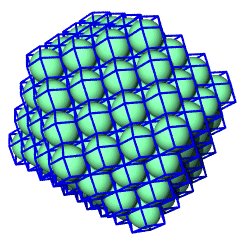You have this recognized elder and chief who gets all these accolades, plus who invents something that makes geometry easier for young people of the tribe, and all without robbing them of anything already on the books.
Then the elder chief dies (1983).
Then all that promising stuff about the whole number volumes and and so on just gets swept under the rug, not shared with the kids, for at least one generation, maybe two (we're still waiting to see), some'd argue three (I'm dating from 1975, but the chief was already old by then).
The question: is this a common pattern in human cultures?
That "invented something," just to be specific, is yet another mandala or "matrix" of interposed polyhedra. We've seen these a lot in both the east and the west.
This one intersects the two tetrahedra, Star of David style, then crosses the resulting cube with its dual, netting Kepler's space-filler rhombic dodecahedron. The respective volumes: 1:3:4:6 as in tetrahedron, cube, octahedron, rhombic dodecahedron.
Now that's not the whole story. If you pack 12 rhombic dodecahedra around the nuclear one, diamond face to diamond face, the 24 outer edges so formed define the rhombic dodecahedron's dual, a cuboctahedron, which weighs in at volume 20.

3-frequency cuboctahedral packing
(92 + 42 + 12 + 1 = 147 balls)
Then you have a way to crack the cube into subpieces, or the coupler if you prefer, to get the 24 and/or 8 MITEs (cube and/or coupler), each dissectible into two As and a B, the As left and right handed, the B either left or right handed.(92 + 42 + 12 + 1 = 147 balls)
And finally, the Jitterbug Transformation, a bridge to the world of five-fold rotationally symmetric shapes, per Hargittai & Hargittai.
That's all pretty easy (no?) especially if you see it cartooned.
The volumes, again: A & B = 1/24; MITE = 1/8, Tetrahedron & Coupler = 1; Cube = 3; Octahedron = 4; Rhombic Dodecahedron = 6; Cuboctahedron = 20. Plus the five-folders (where you'll net your 5 and your 2).
We're not talking Einstein or rocket science here. We're talking basic Sesame Street level visualizations involving primitive shapes, with easy links to low order whole numbers and fractions, yet with threads branching everywhichway into interesting, relevant topics, including into purely mathematical ones (phi, fibonacci).
Our collective resistance to sharing this little gem of interlocked concepts, with our nation's pre-college kids, is something I think will go down in the history books, as well as the anthropology and psychology books, as a story worthy of some focussed analysis (and perhaps some gnashing of teeth).
